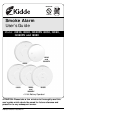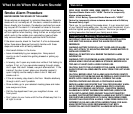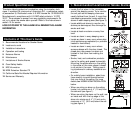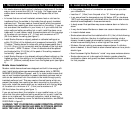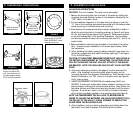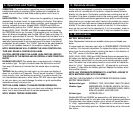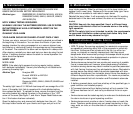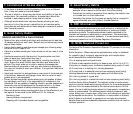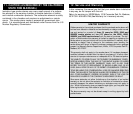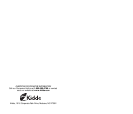
USE ONLY THE FOLLOWING 9 VOLT BATTERIES FOR i9040RV AND
i9060RV SMOKE ALARM BATTERY REPLACEMENT:
Alkaline type: ENERGIZER 522; DURACELL MN1604, MX1604;
PANASONIC 6AM6, 6AM-6, 6AM-6PI, 6AM6X,
AND 6LR61(GA)
NOTE: WEEKLY TESTING IS REQUIRED.
WARNING! USE ONLY THE BATTERIES SPECIFIED. USE OF DIFFER-
ENT BATTERIES MAY HAVE A DETRIMENTAL EFFECT ON THE
SMOKE ALARM.
CLEANING YOUR ALARM
YOUR ALARM SHOULD BE CLEANED AT LEAST ONCE A YEAR
To clean your alarm, remove it from the mounting bracket as outlined in
the beginning of this section. You can clean the interior of your alarm
(sensing chamber) by using compressed air or a vacuum cleaner hose
and blowing or vacuuming through the openings around the perimeter
of the alarm. The outside of the alarm can be wiped with a damp cloth.
After cleaning, reinstall your alarm and test your alarm by using the test
button. If cleaning does not restore the alarm to normal operation the
alarm should be replaced.
SAFETY LIGHT
MODEL i9080
NOTE: If the safety light appears dim during regular testing, replace
both batteries immediately. Use only the following 9 volt batteries for
powering the safety light:
Alkaline Type Energizer 522
Duracell MN1604 or MX1604
Gold Peak 1604A
Panasonic 6AM6, 6AM-6, 6AM-6PI, 6AM6X and
6LR61 (GA)
The safety light has a 6.3 V 250mA fuse lamp with an average life of 50
hours. If the safety light fails to operate with a fresh alkaline battery,
then replace the lamp. To replace the lamp, remove the alarm from the
mounting bracket by rotating the alarm in the direction of the “OFF”
arrow on the cover (See Figure 7, and Alarm Tamper Resist Feature sec-
tion if this feature has been activated).
Open the battery door and remove both batteries from the unit. Grip
the lamp holder handle with your thumb and finger and pull out the
6. Maintenance
7. Limitations of Smoke Alarms
WARNING: PLEASE READ CAREFULLY AND THOROUGHLY
• NFPA 72 states: Fire-warning equipment for residential occupancies
are capable of protecting about half of the occupants in potentially
fatal fires. Victims are often intimate with the fire, too old or too
young, or physically or mentally impaired such that they cannot
escape even when warned early enough that escape should be possi-
ble. For these people, other strategies such as protection-in-place or
assisted escape or rescue would be necessary.
• Smoke alarms are devices that can provide early warning of possible
fires at a reasonable cost; however, alarms have sensing limitations.
Ionization sensing alarms may detect invisible fire particles (associated
with fast flaming fires) sooner than photoelectric alarms. Photoelectric
sensing alarms may detect visible fire particles (associated with slow
smoldering fires) sooner than ionization alarms. Home fires develop in
different ways and are often unpredictable. For maximum protection,
Kidde recommends that both Ionization and Photoelectric alarms be
installed.
• A battery powered alarm must have a battery of the specified type, in
good condition and installed properly.
• AC powered alarms (without battery backup) will not operate if the
AC power has been cut off, such as by an electrical fire or an open
fuse.
• Smoke alarms must be tested regularly to make sure the batteries and
the alarm circuits are in good operating condition.
• Smoke alarms cannot provide an alarm if smoke does not reach the
alarm. Therefore, smoke alarms may not sense fires starting in chim-
neys, walls, on roofs, on the other side of a closed door or on a differ-
ent floor.
lamp holder assembly. Slide the old lamp out of the lamp holder and
replace it with a new lamp. Replace with the correct lamp type: Vanco
#FTB 6 which is available at most radio/tv repair stores.
Reinstall the lamp holder. It will snap easily into the base. Put working
batteries back in the alarm and remount the alarm on its mounting
bracket.
CAUTION: Use only the lamp specified. Use of a different lamp
may have a detrimental effect on the smoke alarm or the safety
light operation.
NOTE: The safety light is not intended to satisfy the requirements
for approved illumination under various local codes. Very thick
and/or dense smoke may obscure the light.
6. Maintenance



